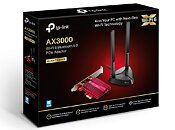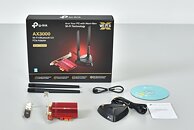Thursday, April 9th 2020

TP-Link Intros Archer TX3000E 802.11ax PCIe WLAN Card
For those of us on older desktops with plenty of PCIe slots to go around, and a brand new 802.11ax router in the house to drive a swanky new gigabit fiber Internet connection, TP-Link released the Archer TX3000E, a PCI-Express add-on card that gives your desktop 802.11ax Wi-Fi 6 and Bluetooth 5.0 connectivity. The product consists of three components, the add-on card, an antenna assembly, and cabling. The add-on card features PCI-Express 2.0 x1 (5 Gbps per direction) host interface, and uses an Intel AX200 WLAN controller that's passively cooled by a heatsink.
The Archer TX3000E supports dual-band 802.11ax, with up to 2402 Mbps on the 5 GHz band, and up to 574 Mbps in the 2.4 GHz band, along with support for WPA3. Besides PCIe, a 4-pin USB 2.0 cable connects to one of your motherboard's vacant USB 2.0 headers, for the Bluetooth 5.0 component to work. The desktop antenna assembly features two multi-directional antennae, and a magnetized base. Available now, the Archer TX3000E is priced at 79.90€.
The Archer TX3000E supports dual-band 802.11ax, with up to 2402 Mbps on the 5 GHz band, and up to 574 Mbps in the 2.4 GHz band, along with support for WPA3. Besides PCIe, a 4-pin USB 2.0 cable connects to one of your motherboard's vacant USB 2.0 headers, for the Bluetooth 5.0 component to work. The desktop antenna assembly features two multi-directional antennae, and a magnetized base. Available now, the Archer TX3000E is priced at 79.90€.



19 Comments on TP-Link Intros Archer TX3000E 802.11ax PCIe WLAN Card
Talk about copycatting the Asus network card colour scheme.
This one looks like ASUS wifi card without Bluetooth, so I thought it has same kind of specs. My bad.
WAV654AX200 chipset, card is 100% identical to ASUS PCE-AX3000. This also means, Linux support on 5.1+ kernel.www.intel.com/content/www/us/en/products/docs/wireless/wi-fi-6-ax200-module-brief.html
I recently bought a Asus wireless card, i hate the "BLOAT" MBPS on the cards. The damn thing does'nt even archieve 150mbit or so on both 2.4 and 5Ghz while being not even 2 meters away from the accesspoint. I am dissapointed in wireless in general again as i was like 10 years ago. The tech comes with perks, ping spikes, sometimes a hard disable / enable the NIC in order to have it connect again, it's never as solid as real NIC with a UTP would be.I've bin checking, but they really dont need any heatsink at all, esp at that size. I guess it's to add something for the eye as a naked wireless card would be completely boring, inside any machine honestly.
The RF transmitters are usually capped, and proberly dont push out more then a half watt or so. Because of that there could never be as much of heat as that heatsink pretends it would be. Maybe some I/O shielding, who knows.
And Ralink acquisition by Mediatek did not help either. Fortunately, Mediatek kept going with legacy product support and later posted a nice fully-functional Win10 driver for RT5592. With that driver I got pretty much the max performance out of my N53, and zero issues on 5GHz band.
I'm not even gonna start my rant on their Linux drivers.